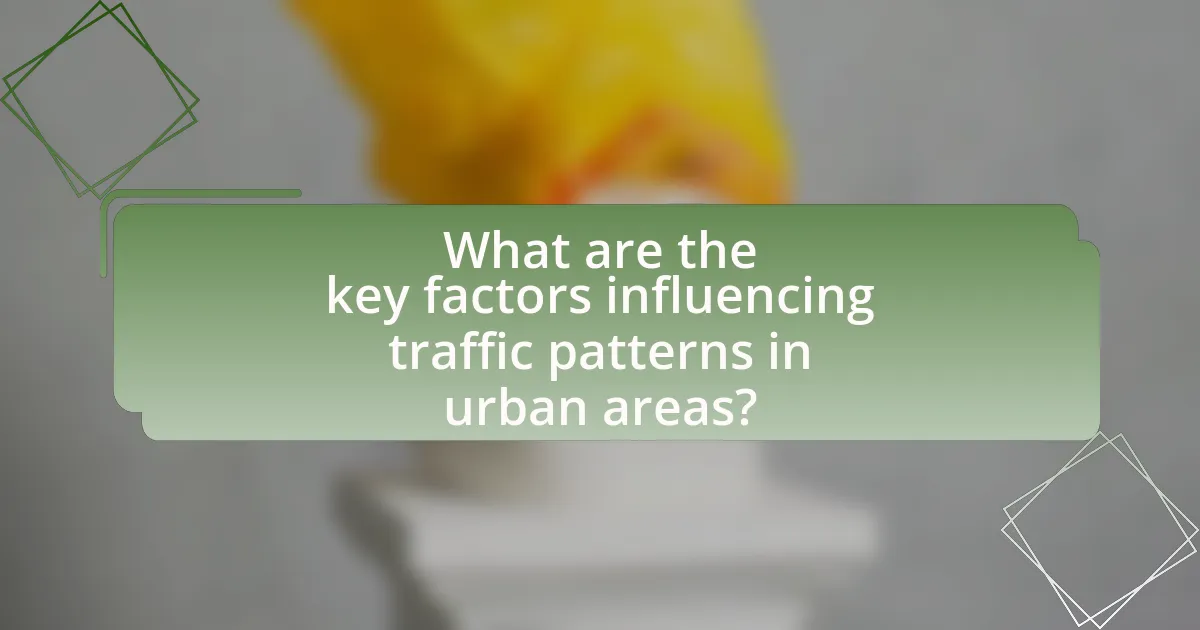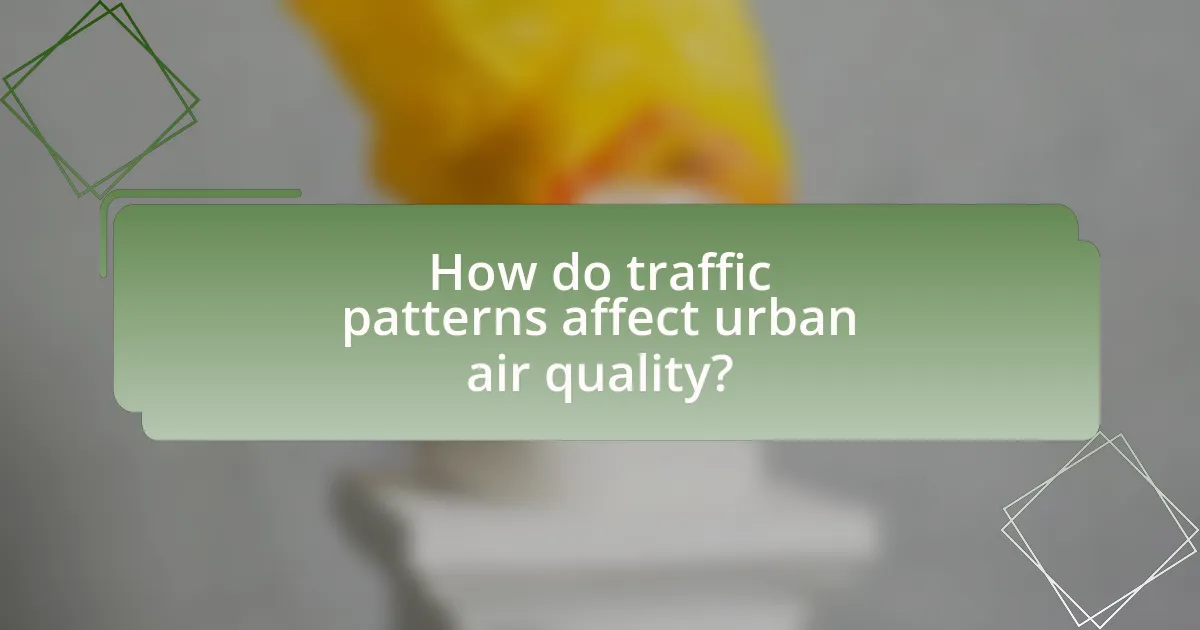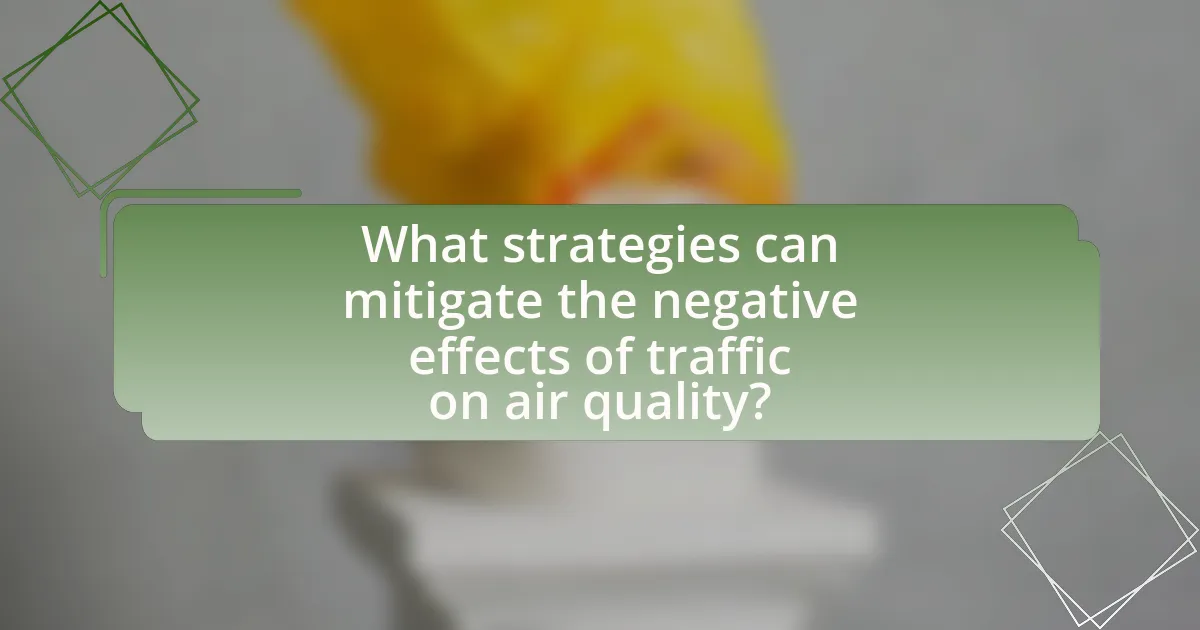The article examines the effects of traffic patterns on urban air quality, identifying key factors such as road infrastructure, population density, land use, public transportation availability, and traffic regulations that influence traffic behavior in cities. It discusses how urban design and infrastructure impact traffic flow, the role of different road types, and the significance of public transportation in reducing congestion. Additionally, the article explores external factors like weather conditions and special events that alter traffic patterns, as well as the relationship between traffic volume and pollutant levels. Strategies for mitigating the negative effects of traffic on air quality, including urban planning and technological advancements, are also highlighted, emphasizing the importance of sustainable transportation methods for improving urban air quality.
What are the key factors influencing traffic patterns in urban areas?

Key factors influencing traffic patterns in urban areas include road infrastructure, population density, land use, public transportation availability, and traffic regulations. Road infrastructure, such as the number of lanes and traffic signals, directly affects vehicle flow and congestion levels. Population density influences the volume of vehicles on the road, as higher densities typically lead to increased traffic. Land use patterns, including the proximity of residential areas to commercial zones, impact travel distances and modes of transportation. The availability of public transportation options can reduce reliance on personal vehicles, thereby altering traffic patterns. Traffic regulations, such as speed limits and congestion pricing, also play a significant role in shaping how traffic moves through urban environments. These factors collectively determine the efficiency and behavior of traffic in cities, impacting urban air quality as a result.
How do urban design and infrastructure affect traffic flow?
Urban design and infrastructure significantly influence traffic flow by determining the layout, connectivity, and capacity of road networks. Well-planned urban areas with efficient road designs, such as grid patterns and multi-modal transport options, facilitate smoother traffic movement and reduce congestion. For instance, cities that incorporate dedicated bike lanes and public transit systems can decrease reliance on personal vehicles, leading to lower traffic volumes. Research indicates that urban areas with mixed-use developments promote shorter trips and increased walking, which can alleviate traffic congestion. A study by the Victoria Transport Policy Institute found that compact urban designs can reduce vehicle travel by 20-40%, demonstrating a direct correlation between urban planning and traffic efficiency.
What role do road types and layouts play in traffic patterns?
Road types and layouts significantly influence traffic patterns by determining vehicle flow, speed, and congestion levels. For instance, arterial roads facilitate higher traffic volumes and faster speeds, while local roads often experience slower speeds and lower volumes due to their design and purpose. Research indicates that road configurations, such as the presence of roundabouts versus traffic signals, can reduce delays and improve traffic efficiency, thereby affecting overall traffic behavior. Studies show that well-designed road layouts can decrease stop-and-go conditions, which are linked to increased emissions and poor air quality.
How does public transportation availability impact traffic congestion?
Public transportation availability significantly reduces traffic congestion by providing an alternative to private vehicle use. When public transit options are accessible and efficient, more individuals opt for these services instead of driving, leading to fewer cars on the road. For instance, a study by the American Public Transportation Association found that public transit use in the U.S. saves approximately 4.2 billion gallons of gasoline annually, which translates to a reduction in traffic congestion. Additionally, cities with robust public transportation systems, such as New York and San Francisco, experience lower levels of congestion compared to those with limited options, demonstrating a clear correlation between transit availability and reduced traffic.
What external factors contribute to changes in traffic patterns?
External factors that contribute to changes in traffic patterns include weather conditions, economic activity, and urban development. Weather conditions, such as rain or snow, can lead to reduced vehicle speeds and altered routes, impacting overall traffic flow. Economic activity influences traffic volume; for instance, increased employment rates typically result in higher commuter traffic. Urban development, including new road construction or changes in land use, can redirect traffic and create congestion in different areas. These factors collectively shape how traffic patterns evolve over time, affecting urban air quality as vehicle emissions fluctuate with traffic changes.
How do weather conditions influence traffic behavior?
Weather conditions significantly influence traffic behavior by affecting driver visibility, road traction, and overall driving comfort. For instance, rain and snow can lead to reduced visibility and slippery roads, prompting drivers to slow down and increase following distances, which can result in lower traffic speeds and increased congestion. Studies have shown that during adverse weather conditions, such as heavy rain, traffic speeds can decrease by up to 30%, leading to longer travel times. Additionally, extreme weather events, like storms or heavy snowfall, can cause road closures and detours, further altering traffic patterns. These changes in traffic behavior due to weather conditions can subsequently impact urban air quality, as variations in vehicle emissions are linked to traffic flow and congestion levels.
What impact do special events have on urban traffic patterns?
Special events significantly disrupt urban traffic patterns by increasing vehicle volume and altering travel routes. For instance, events such as concerts, sports games, or festivals often lead to road closures and detours, which can create congestion in surrounding areas. A study by the Texas A&M Transportation Institute found that major events can increase traffic delays by up to 50% in urban centers, highlighting the direct correlation between special events and traffic disruptions. Additionally, the influx of attendees typically results in a higher demand for parking, further exacerbating traffic issues as vehicles search for available spaces.
How do traffic patterns affect urban air quality?

Traffic patterns significantly impact urban air quality by influencing the levels of pollutants emitted from vehicles. Increased traffic congestion leads to higher emissions of nitrogen oxides, particulate matter, and volatile organic compounds, which degrade air quality. For instance, a study published in the journal “Environmental Science & Technology” found that areas with heavy traffic experience elevated concentrations of these pollutants, contributing to respiratory issues and other health problems among urban populations. Additionally, traffic flow dynamics, such as stop-and-go conditions, exacerbate emissions compared to steady driving, further deteriorating air quality in densely populated areas.
What pollutants are primarily emitted from vehicles in urban settings?
Vehicles in urban settings primarily emit nitrogen oxides (NOx), carbon monoxide (CO), particulate matter (PM), volatile organic compounds (VOCs), and sulfur dioxide (SO2). These pollutants result from fuel combustion and contribute significantly to urban air pollution. For instance, according to the Environmental Protection Agency (EPA), transportation is a major source of NOx and CO emissions, which are key contributors to smog formation and respiratory problems. Additionally, the World Health Organization (WHO) highlights that particulate matter from vehicle emissions can penetrate deep into the lungs, posing serious health risks.
How do different types of vehicles contribute to air pollution?
Different types of vehicles contribute to air pollution primarily through the emission of harmful pollutants such as nitrogen oxides, particulate matter, and volatile organic compounds. Gasoline-powered cars and trucks release significant amounts of carbon monoxide and hydrocarbons, which contribute to smog formation. Diesel vehicles emit higher levels of nitrogen oxides and particulate matter, which are linked to respiratory issues and environmental degradation. According to the Environmental Protection Agency, transportation accounts for approximately 29% of total greenhouse gas emissions in the United States, highlighting the substantial impact of various vehicle types on air quality.
What is the relationship between traffic volume and pollutant levels?
Increased traffic volume correlates with elevated pollutant levels in urban areas. Studies indicate that higher vehicle counts lead to greater emissions of nitrogen oxides, particulate matter, and volatile organic compounds. For instance, research conducted by the Environmental Protection Agency shows that a 10% increase in traffic volume can result in a 5-10% rise in local air pollutants. This relationship is primarily due to the combustion of fossil fuels in vehicles, which releases harmful substances into the atmosphere, thereby degrading air quality.
How do traffic congestion and stop-and-go conditions impact air quality?
Traffic congestion and stop-and-go conditions significantly degrade air quality by increasing emissions of pollutants such as nitrogen oxides and particulate matter. During congestion, vehicles operate inefficiently, leading to higher fuel consumption and greater emissions per mile traveled. Studies indicate that stop-and-go traffic can increase emissions by up to 40% compared to steady driving conditions. This elevated emission level contributes to the formation of ground-level ozone and smog, which are harmful to human health and the environment.
What are the short-term and long-term effects of congestion on air pollution?
Congestion significantly increases air pollution in both the short-term and long-term. In the short-term, traffic congestion leads to higher emissions of nitrogen oxides and particulate matter due to idling vehicles and stop-and-go traffic, which can result in immediate health impacts such as respiratory issues and increased hospital visits. Studies indicate that during peak congestion periods, emissions can rise by up to 50% compared to free-flowing traffic conditions.
In the long-term, persistent congestion contributes to elevated levels of air pollutants, which can lead to chronic health problems, environmental degradation, and climate change. Research shows that areas with consistent traffic congestion experience higher rates of asthma and cardiovascular diseases among residents. Furthermore, long-term exposure to elevated air pollution levels can result in significant economic costs related to healthcare and lost productivity, with estimates suggesting that air pollution costs the U.S. economy over $150 billion annually in healthcare expenses.
How does idling contribute to urban air quality issues?
Idling significantly contributes to urban air quality issues by releasing harmful pollutants into the atmosphere. When vehicles remain stationary with their engines running, they emit carbon dioxide, nitrogen oxides, and particulate matter, which degrade air quality and can lead to respiratory problems in urban populations. According to the U.S. Environmental Protection Agency, idling can produce up to 0.4 grams of nitrogen oxides per minute, exacerbating smog formation and contributing to health risks. Furthermore, studies indicate that reducing idling time can improve air quality by decreasing overall emissions, highlighting the direct link between idling behavior and urban air pollution levels.
What strategies can mitigate the negative effects of traffic on air quality?

Implementing strategies such as promoting public transportation, enhancing cycling and walking infrastructure, and adopting stricter emissions regulations can significantly mitigate the negative effects of traffic on air quality. Public transportation reduces the number of individual vehicles on the road, which lowers overall emissions; for instance, a study by the American Public Transportation Association found that public transit use saves 45 million metric tons of CO2 annually. Additionally, investing in cycling and walking infrastructure encourages non-motorized transport, which further decreases vehicle emissions. Stricter emissions regulations for vehicles, such as those enforced in California, have been shown to improve air quality by reducing pollutants like nitrogen oxides and particulate matter. These strategies collectively contribute to cleaner air in urban environments.
How can urban planning reduce traffic-related air pollution?
Urban planning can reduce traffic-related air pollution by implementing strategies such as mixed-use development, enhancing public transportation, and creating pedestrian-friendly environments. Mixed-use development encourages proximity between residential, commercial, and recreational spaces, which reduces the need for long car trips. Enhancing public transportation systems makes them more accessible and efficient, leading to decreased reliance on personal vehicles. Additionally, designing pedestrian-friendly environments promotes walking and cycling, further minimizing vehicle emissions. Research indicates that cities with well-planned public transport and walkable neighborhoods experience significantly lower levels of air pollution, as evidenced by studies showing that improved public transit can reduce vehicle miles traveled by up to 30%.
What role do green spaces play in improving urban air quality?
Green spaces play a crucial role in improving urban air quality by acting as natural filters for pollutants. They absorb carbon dioxide and release oxygen through photosynthesis, which helps mitigate the effects of traffic emissions. Additionally, vegetation in green spaces captures particulate matter and other harmful substances from the air, reducing their concentration in urban environments. Studies have shown that urban areas with more green spaces experience lower levels of air pollution, with a significant reduction in nitrogen dioxide and particulate matter, contributing to better overall public health.
How can mixed-use developments influence traffic patterns positively?
Mixed-use developments can positively influence traffic patterns by reducing the need for long commutes and encouraging walking and cycling. By integrating residential, commercial, and recreational spaces, these developments create environments where people can live, work, and play in close proximity. This proximity decreases reliance on automobiles, leading to fewer vehicle trips and lower traffic congestion. Studies, such as the one conducted by the Urban Land Institute, indicate that mixed-use developments can reduce vehicle miles traveled by up to 30%, which contributes to improved urban air quality by decreasing emissions from vehicles.
What technological solutions are available to improve air quality in urban areas?
Technological solutions available to improve air quality in urban areas include air quality monitoring systems, pollution control technologies, and green infrastructure. Air quality monitoring systems utilize sensors and data analytics to provide real-time information on pollution levels, enabling cities to respond effectively. Pollution control technologies, such as catalytic converters and particulate filters, reduce emissions from vehicles and industrial sources. Green infrastructure, including urban trees and green roofs, enhances air quality by absorbing pollutants and providing shade, which can lower urban temperatures. These solutions are supported by studies indicating that cities implementing such technologies have seen significant reductions in air pollution levels, thereby improving public health and environmental quality.
How do electric vehicles contribute to reducing urban air pollution?
Electric vehicles contribute to reducing urban air pollution by eliminating tailpipe emissions, which are a significant source of pollutants such as nitrogen oxides and particulate matter. Unlike conventional gasoline or diesel vehicles, electric vehicles operate on electricity, producing zero emissions during operation. According to the U.S. Environmental Protection Agency, transportation accounts for nearly 29% of total greenhouse gas emissions, with a substantial portion stemming from traditional vehicles. By replacing these with electric vehicles, cities can significantly lower the concentration of harmful pollutants in the air, leading to improved public health outcomes and enhanced air quality. Studies have shown that widespread adoption of electric vehicles could reduce urban air pollution levels by up to 50% in densely populated areas, demonstrating their effectiveness in combating air quality issues.
What advancements in traffic management systems can help improve air quality?
Advancements in traffic management systems that can help improve air quality include the implementation of adaptive traffic signal control, real-time traffic monitoring, and vehicle emission tracking technologies. Adaptive traffic signal control optimizes traffic flow by adjusting signal timings based on current traffic conditions, which reduces idling and congestion, leading to lower emissions. Real-time traffic monitoring systems utilize sensors and cameras to gather data on traffic patterns, enabling better route planning and reducing unnecessary vehicle trips. Additionally, vehicle emission tracking technologies can identify high-emission vehicles, allowing for targeted interventions such as incentives for cleaner vehicles or restrictions on older, polluting models. These advancements collectively contribute to reduced vehicle emissions and improved urban air quality.
What practical steps can individuals take to reduce their impact on urban air quality?
Individuals can reduce their impact on urban air quality by adopting sustainable transportation methods, such as walking, cycling, or using public transit instead of driving personal vehicles. These alternatives significantly decrease the number of cars on the road, which in turn reduces emissions of pollutants like nitrogen oxides and particulate matter. For instance, a study by the Environmental Protection Agency indicates that reducing vehicle use by just 10% can lead to a measurable improvement in air quality, as fewer vehicles contribute to lower overall emissions. Additionally, individuals can support and advocate for policies that promote green spaces and urban planning that prioritizes pedestrian and cyclist infrastructure, further enhancing air quality in urban environments.

Leave a Reply